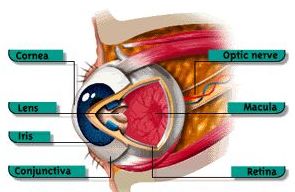

Conjunctiva
The conjuntiva is a clear layer that covers and protects the inside of the eyelids and the front part of the sclera (the white part of the eyes). A picture of the conjunctiva is shown to the right. The clear layer that makes up the conjunctiva is made of a mucous membrane. A mucous membrane is one of four major types of thin sheets of tissue that line or cover various parts of the body. Cells in the conjunctiva make a fluid that is similar to tears. This fluid helps moisten the eyelids and the cornea. The cornea is the clear covering at the front of the eyeball. The cornea can be seen in the picture to the right.
Blood vessels inside of the conjunctiva normally cannot be seen. However, when the conjunctiva becomes inflamed (a condition known as conjunctivitis), the blood vessels become filled with blood and are visible. Conjunctivitis is commonly referred to as pinkeye. Other inflammatory conditions can also cause the blood vessels in the conjunctiva to fill up with blood and become visible. More than one conjunctivae is written as "conjunctivae." The conjunctiva is also known as the tunica conjunctiva. Conjunctiva comes from the Latin word "conjunctivus" meaning "connecting."
Blood vessels inside of the conjunctiva normally cannot be seen. However, when the conjunctiva becomes inflamed (a condition known as conjunctivitis), the blood vessels become filled with blood and are visible. Conjunctivitis is commonly referred to as pinkeye. Other inflammatory conditions can also cause the blood vessels in the conjunctiva to fill up with blood and become visible. More than one conjunctivae is written as "conjunctivae." The conjunctiva is also known as the tunica conjunctiva. Conjunctiva comes from the Latin word "conjunctivus" meaning "connecting."


MedFriendly®
"Where Medical Information is Easy to Understand"™




